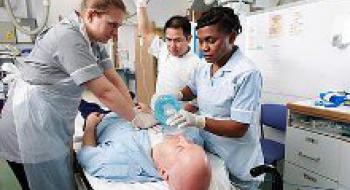High fidelity simulation in the clinical setting

Best Practice: To give the emergency teams an opportunity to practise multi-disciplinary team-working within their normal clinical environment. This is done through the use of trained facilitators in simulated events with the addition of an in-depth debrief at the end of the event, supported by video feedback.
Who did it: Dr Louise Woolrich-Burt, Dr Carl Hillerman, Stephen Turner, Alexandra McCurdie and Catherine Baldock, all from the University Hospital Coventry and Warwickshire NHS Trust.
Within the trust there are emergency teams which respond to adult and paediatric medical emergencies, trauma calls and cardiac arrests. The aim of our high fidelity (HF) simulated events was to give the emergency teams an opportunity to practise mult-idisciplinary team-working within their normal clinical environment. To achieve this, we used trained facilitators in simulated events with the addition of an in depth debrief at the end of the event, supported by video feedback.
Emergency training commonly takes place within a classroom or specialist training environment and although this allows for staff to be trained in a controlled environment free from clinical distractions, it doesn't replicate the true clinical experience. In order to maximise the fidelity of the scenario, we made the decision to relocate the training to within the clinical environment within which the emergency teams would normally work. We initially undertook adult simulation within the resuscitation area of the emergency department, focusing on multiple trauma and activation of the massive transfusion protocol that was newl- introduced in the trust.
In order to ensure team compliance, while not compromising patient safety, we liaised with all clinical leads from relevant specialities who would normally attend a trauma alert. The calls to attend were put out as "practice trauma alert ED" to be clear that staff knew it was a simulated event and ensure that if they were undertaking urgent clinical procedures they would not compromise patient safety by attending. Scenarios generally involved multiple injuries and varying levels of consciousness. Team debriefs were carried out immediately afterwards.
Attendance from the trauma team was very good and the simulation also provided an opportunity to test the system for the necessity for a massive blood transfusion.
Since starting the HF similation sessions, we have developed a similar model for paediatric emergencies in both the Emergency Department and Paediatric High Dependency Unit (HDU). Attendance of the paediatric team was pre-determined on these occasions in order to utilise professional development time.
Our future plans include further simulated events in the clinical setting expanding on our existing range of scenarios and utilising different techniques and technologies to further improve the learning experience.
For more information, please contact Dr Helen Goodyear, Associate Postgraudate Dean for Careers, at Helen.Goodyear@wm.hee.nhs.uk